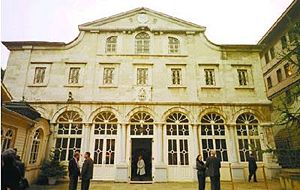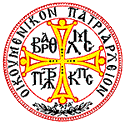Church of Constantinople
| Ecumenical Patriarchate of Constantinople | |
| Founder(s) | Apostle Andrew |
| Autocephaly/Autonomy declared | Traditional |
| Autocephaly/Autonomy recognized | Traditional |
| Current primate | Patriarch Bartholomew I |
| Headquarters | Istanbul, Turkey |
| Primary territory | Constantinople, most of Turkey, Mount Athos, Crete, parts of Northern Greece, the Dodecanese |
| Possessions abroad | United States, Canada, Great Britain, Western Europe, South America, Central America, Australia, Southeast Asia |
| Liturgical language(s) | Greek, English |
| Musical tradition | Byzantine Chant |
| Calendar | Revised Julian, Julian |
| Population estimate | 3,500,000 |
| Official website | Church of Constantinople |
The Church of Constantinople is one of the fourteen or fifteen autocephalous churches, also referred to as the Ecumenical Patriarchate. It is headed by the Ecumenical Patriarch, who has the status of primus inter pares ("first among equals") among the world's Orthodox bishops. The local churches of the Ecumenical Patriarchate consist of five archdioceses, three churches, thirteen metropolises, and one diocese, each of which reports directly to the Patriarch of Constantinople with no intervening authority. In addition, three of the five archdioceses have internal metropolises (16 in all), which are part of their respective archdioceses rather than distinct administrative entities, unlike the other metropolises.
The current Ecumenical Patriarch is His All-Holiness Bartholomew I, Archbishop of Constantinople.
Contents
Metropolitanates of Constantinople
See Main Article Church of Constantinople Structure
The Church of Constantinople is headed by the Patriarch of Constantinople and is split into a number of Metropolitanates as listed below.
|
Places of Pilgrimage
Some sites of pilgrimage are no longer owned by the Church nor function as orthodox centres but are historically connected and of great significance to Orthodoxy.
Peculiar prerogatives of the patriarchate
Main article: Prerogatives of the Ecumenical Patriarchate

The following is a (non-exhaustive) list of these prerogatives and their reference points:
- Equal prerogatives to Old Rome (Canon 3 of the Second Ecumenical Council, Canon 28 of the Fourth Ecumenical Council, Canon 36 of the Quinisext Council)
- The right to hear appeals, if invited, regarding disputes between clergy (Canons 9 and 17 of the Fourth Ecumenical Council)
- The right to ordain bishops for areas outside defined canonical boundaries (Canon 28 of the Fourth Ecumenical Council)
- The right to establish stavropegial monasteries even in the territories of other patriarchates (the Epanagoge, commentaries of Matthew Blastares and Theodore Balsamon)
See also
- Hierarchical Succession
- The Holy and Sacred Synod, The Holy and Sacred Synod of the Ecumenical Patriarchate is presided over by His All-Holiness Bartholomew I, Archbishop of Constantinople and is comprised of XX Metropolitans.
- Theological Institutions
- Ecumenical Patriarchate in America
- Greek Orthodox Metropolis of Mexico, Central America, Columbia, Venezuela, and the Caribbean Islands
| Autocephalous and Autonomous Churches of Orthodoxy |
| Autocephalous Churches |
| Four Ancient Patriarchates: Constantinople · Alexandria · Antioch · Jerusalem Russia · Serbia · Romania · Bulgaria · Georgia · Cyprus · Greece · Poland · Albania · Czech Lands and Slovakia · OCA* · Ukraine* |
| Autonomous Churches |
| Sinai · Finland · Estonia* · Japan* · China* · Ukraine* |
| The * designates a church whose autocephaly or autonomy is not universally recognized. |
External links
- Official website of the Patriarchate of Constantinople
- Official website of the Permanent Representation of the Ecumenical Patriarchate to the World Council of Churches
- Eastern Christian Churches: Patriarchate of Constantinople by Ronald Roberson, a Roman Catholic priest and scholar
- The Origins and Authority of the Ecumenical Patriarchate of the Orthodox Church, by Demetrios J. Constantelos
- Caesaropapism?: Theodore Balsamon on the Powers of the Patriarch of Constantinople, by Paul Halsall
- Chalcedon Canon 28: Yesterday and Today, by Rev. John H. Erickson
- Constantinople and Rome: A Survey of the Relations between the Byzantine and the Roman Churches, by Milton V. Anastos
- Brief Historical Note Regarding the Ecumenical Patriarchate, from the official website
- Prof. Thomas Mathews. The Byzantine Churches of Constantinople. New York University (Institute of fine Arts).
- Byzantium 1200 (Byzantium 1200 is a project aimed at creating computer reconstructions of the Byzantine Monuments located in Istanbul, TURKEY as of year 1200 AD).
- Timeline
- Virtual tour
- History
- History - video
- Articles Critical of Actions of Positions of the Ecumenical Patriarchate
- The Legal Status of the Ecumenical Patriarchate by Jaakko Husa, Professor of Constitutional Law and General Jurisprudence at the University of Joensuu (Finland) / Ortodoksi.net



